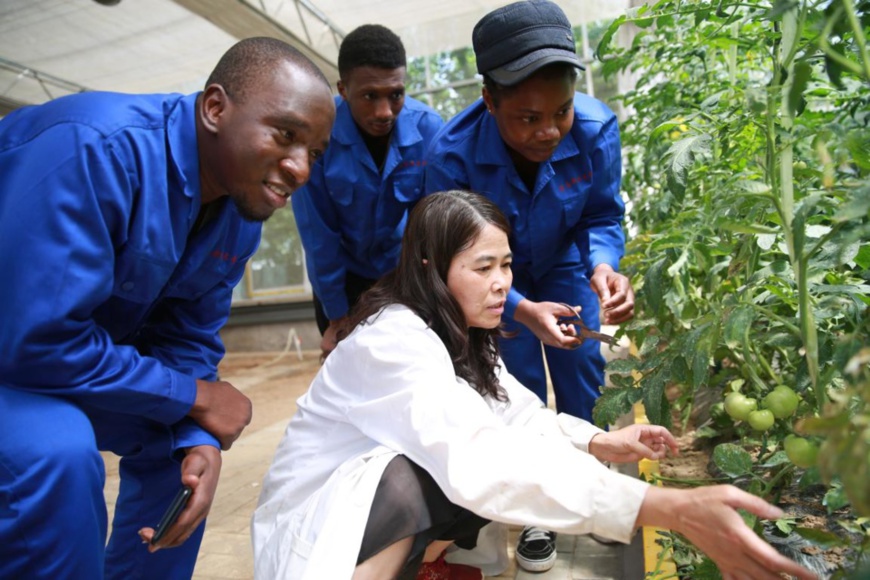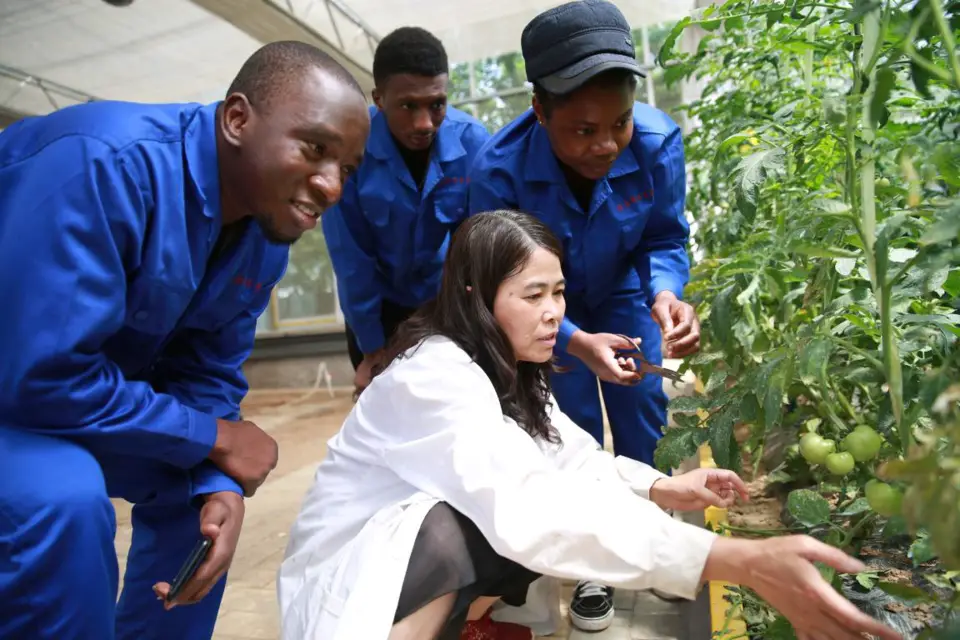By the center for promoting the Belt and Road Initiative under the National Development and Reform Commission of China

Guinean students in China learn agricultural knowledge and technologies from a teacher at a training base in Weinan, northwest China's Shaanxi province, under the framework of the Belt and Road Initiative, May 28, 2020. (Photo by Niu Gang/People's Daily Online)
Although the COVID-19 pandemic raging across the world landed a severe blow on the global economy in 2020, China and other countries along the Belt and Road have secured hard-won results and made solid progress in the joint construction of the Belt and Road Initiative (BRI), which has shown impressive resilience, vitality and appeal amid the pandemic.
Last year, countries along the Belt and Road fought against the virus through solidarity and put into practice the idea of building a community with a shared future for mankind in international anti-epidemic cooperation.
When China was in the depth of its own fight against the COVID-19, countries along the Belt and Road actively supported the Chinese people. A total of 79 countries and 10 international organizations have provided anti-epidemic materials for China.
While under huge pressure in containing the epidemic at home, China has offered assistance to more than 150 countries and 10 international organizations for their fight against the COVID-19, and sent 36 medical expert teams to 34 countries in need.
As the largest producer of medical supplies, China has sent more than 220 billion masks, 2.25 billion protective suits and 1.02 billion testing kits to countries across the globe.
Meanwhile, digital technologies of the country have played an important role in facilitating global anti-epidemic cooperation.
Huawei Cloud, the cloud computing unit of Chinese telecoms company Huawei Technologies Co., Ltd., has launched several digital medical devices. Chinese tech giant Tencent has provided digital communication tools for the United Nations and other international organizations.
In addition, Chinese education software, such as DingTalk and Feishu, have entered the list of United Nations Educational, Scientific and Cultural Organization (UNESCO) recommendations for global distance learning solutions, becoming the first choice in remote learning for 421 million students in 39 countries and regions.
While preventing and controlling the pandemic, China conducted close consultations and signed cooperation documents on jointly building the BRI with the African Union, the International Seabed Authority, Ukraine, Kiribati and other parties.
By the end of 2020, China had signed 203 BRI cooperation documents with 138 countries and 31 international organizations.
China has managed to balance epidemic prevention and control with the construction of overseas projects, and greatly improved infrastructure connectivity in various countries.
Seventy projects under the framework of the China-Pakistan Economic Corridor have progressed in an orderly manner, during which there has been zero COVID-19 infection among employees at the sites of these projects.
The entire second phase of the Karakoram Highway and the Sukkur-Multan section of the Peshawar-Karachi Motorway in Pakistan have successfully opened to traffic, and the construction of the Matiari–Lahore direct current transmission line was fully completed during the pandemic.
In the meantime, Tunnel No. 1 of the Jakarta-Bandung high-speed railway and all tunnels along the China-Laos railway were successfully holed through, the left line of the Belgrade-Zemun section and the left line of the Zemun-Batajnica section of the Hungary-Serbia railway in Serbia were opened to traffic, and the steel beam of the main structure of the Padma Bridge in Bangladesh was closed.
China has taken the lead in resuming work and production, and gradually smoothened foreign trade industrial and supply chains, becoming an anchor of stability for global industrial and supply chains.
In 2020, China steadily advanced economic, trade, and investment cooperation with countries along the Belt and Road. China's imports and exports with countries along the routes of the BRI totaled 9.37 trillion yuan ($1.45 trillion), up 1 percent year on year.
During the first 11 months of 2020, China's non-financial direct investment in countries along the routes reached $15.96 billion, a year-on-year increase of 24.9 percent. The amount accounted for 16.8 percent of China's total non-financial direct investment in foreign countries during the period, 3.9 percentage points higher than that of the previous year.
Last year, China-Europe freight trains carried badly-needed medical supplies and necessities for the resumption of work and production to various countries, helping ensure normal production and life in these countries.
A total of 12,400 trips were made by China-Europe freight trains in 2020, marking a 50-percent year-on-year growth. With 98.4 percent of the containers being fully loaded with goods, these trains reached 21 countries and 97 cities in Europe.
Source: People’s Daily
Last year, countries along the Belt and Road fought against the virus through solidarity and put into practice the idea of building a community with a shared future for mankind in international anti-epidemic cooperation.
When China was in the depth of its own fight against the COVID-19, countries along the Belt and Road actively supported the Chinese people. A total of 79 countries and 10 international organizations have provided anti-epidemic materials for China.
While under huge pressure in containing the epidemic at home, China has offered assistance to more than 150 countries and 10 international organizations for their fight against the COVID-19, and sent 36 medical expert teams to 34 countries in need.
As the largest producer of medical supplies, China has sent more than 220 billion masks, 2.25 billion protective suits and 1.02 billion testing kits to countries across the globe.
Meanwhile, digital technologies of the country have played an important role in facilitating global anti-epidemic cooperation.
Huawei Cloud, the cloud computing unit of Chinese telecoms company Huawei Technologies Co., Ltd., has launched several digital medical devices. Chinese tech giant Tencent has provided digital communication tools for the United Nations and other international organizations.
In addition, Chinese education software, such as DingTalk and Feishu, have entered the list of United Nations Educational, Scientific and Cultural Organization (UNESCO) recommendations for global distance learning solutions, becoming the first choice in remote learning for 421 million students in 39 countries and regions.
While preventing and controlling the pandemic, China conducted close consultations and signed cooperation documents on jointly building the BRI with the African Union, the International Seabed Authority, Ukraine, Kiribati and other parties.
By the end of 2020, China had signed 203 BRI cooperation documents with 138 countries and 31 international organizations.
China has managed to balance epidemic prevention and control with the construction of overseas projects, and greatly improved infrastructure connectivity in various countries.
Seventy projects under the framework of the China-Pakistan Economic Corridor have progressed in an orderly manner, during which there has been zero COVID-19 infection among employees at the sites of these projects.
The entire second phase of the Karakoram Highway and the Sukkur-Multan section of the Peshawar-Karachi Motorway in Pakistan have successfully opened to traffic, and the construction of the Matiari–Lahore direct current transmission line was fully completed during the pandemic.
In the meantime, Tunnel No. 1 of the Jakarta-Bandung high-speed railway and all tunnels along the China-Laos railway were successfully holed through, the left line of the Belgrade-Zemun section and the left line of the Zemun-Batajnica section of the Hungary-Serbia railway in Serbia were opened to traffic, and the steel beam of the main structure of the Padma Bridge in Bangladesh was closed.
China has taken the lead in resuming work and production, and gradually smoothened foreign trade industrial and supply chains, becoming an anchor of stability for global industrial and supply chains.
In 2020, China steadily advanced economic, trade, and investment cooperation with countries along the Belt and Road. China's imports and exports with countries along the routes of the BRI totaled 9.37 trillion yuan ($1.45 trillion), up 1 percent year on year.
During the first 11 months of 2020, China's non-financial direct investment in countries along the routes reached $15.96 billion, a year-on-year increase of 24.9 percent. The amount accounted for 16.8 percent of China's total non-financial direct investment in foreign countries during the period, 3.9 percentage points higher than that of the previous year.
Last year, China-Europe freight trains carried badly-needed medical supplies and necessities for the resumption of work and production to various countries, helping ensure normal production and life in these countries.
A total of 12,400 trips were made by China-Europe freight trains in 2020, marking a 50-percent year-on-year growth. With 98.4 percent of the containers being fully loaded with goods, these trains reached 21 countries and 97 cities in Europe.
Source: People’s Daily
 Menu
Menu
 Joint construction of Belt and Road sees new progress despite COVID-19
Joint construction of Belt and Road sees new progress despite COVID-19
















